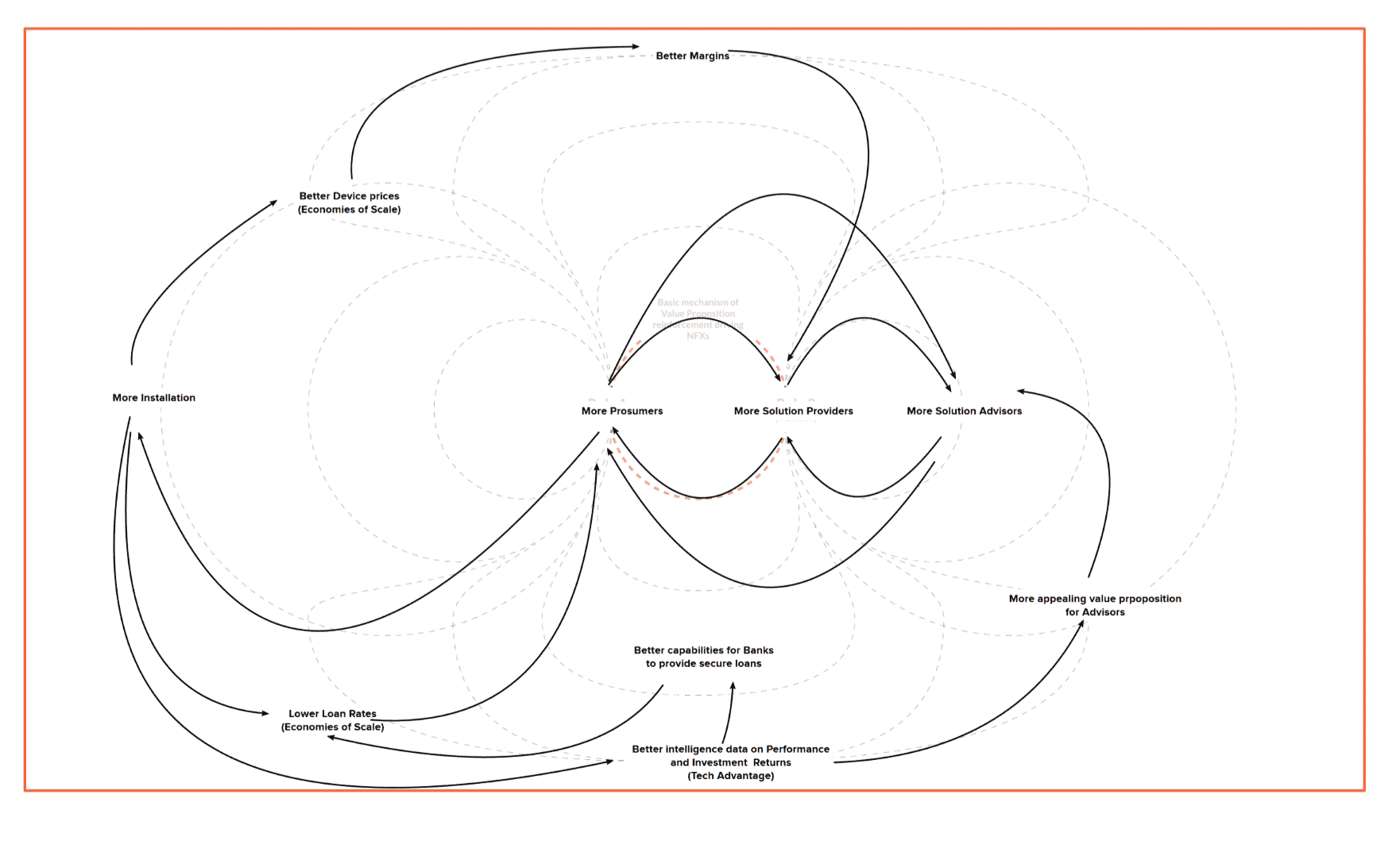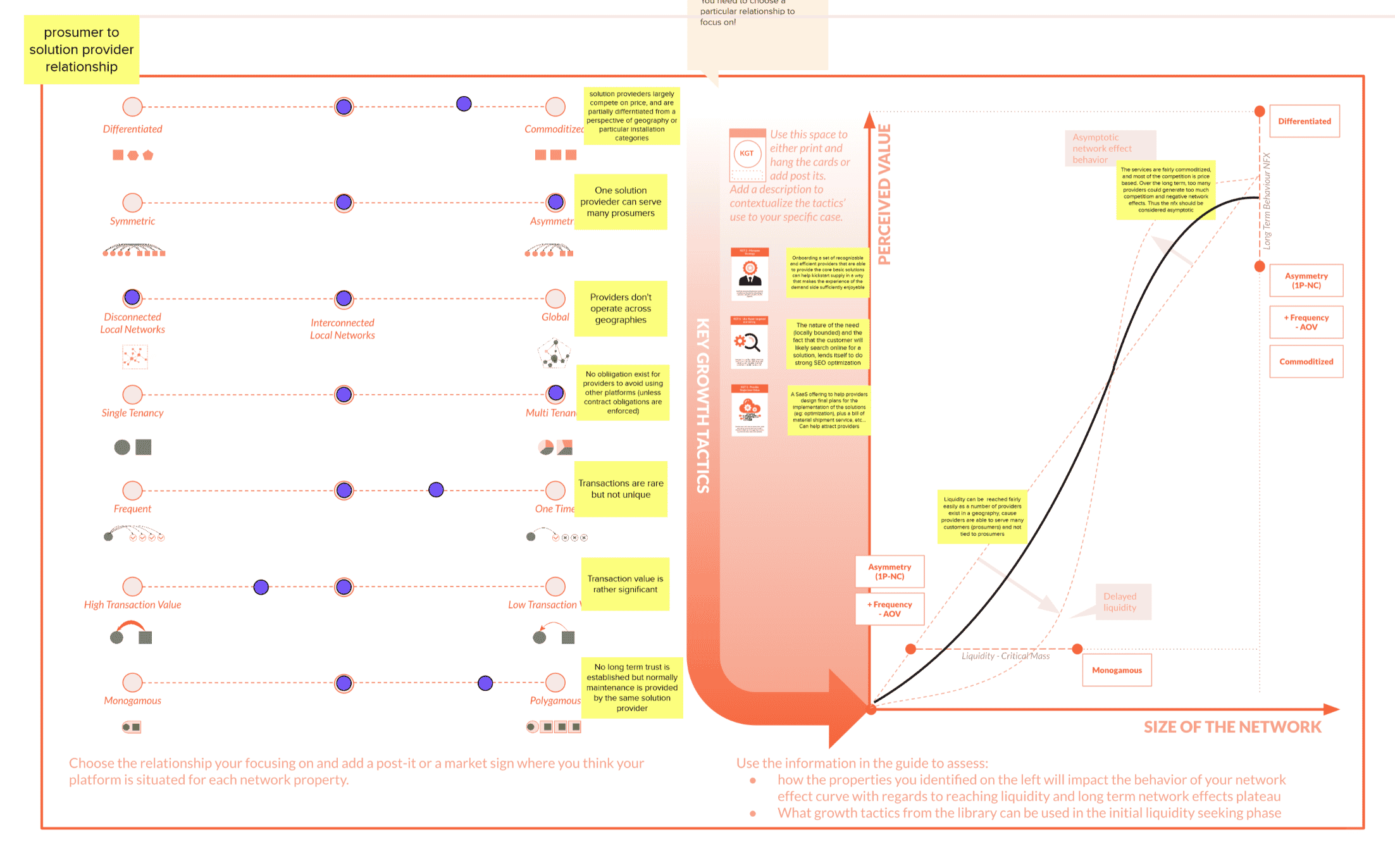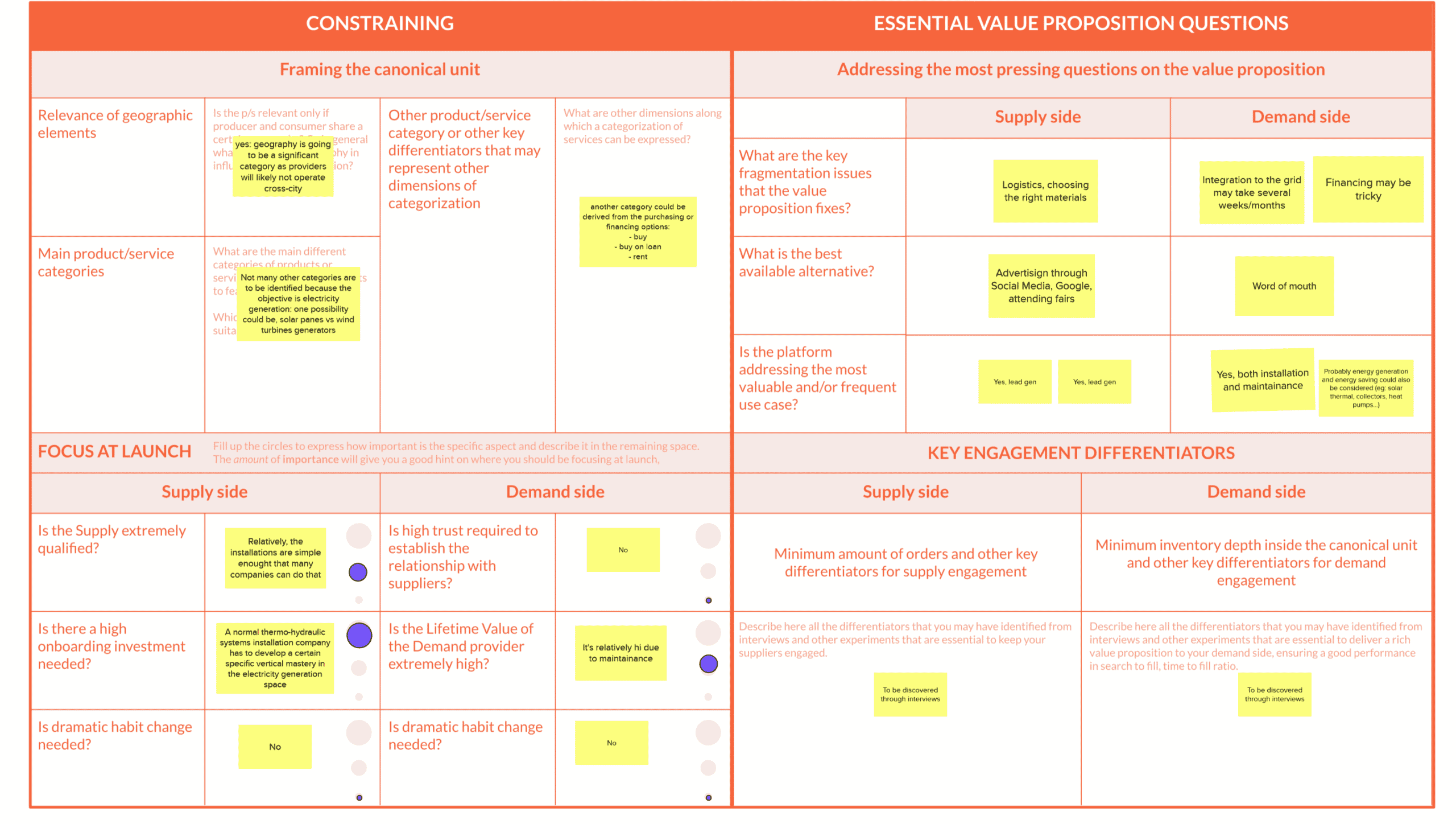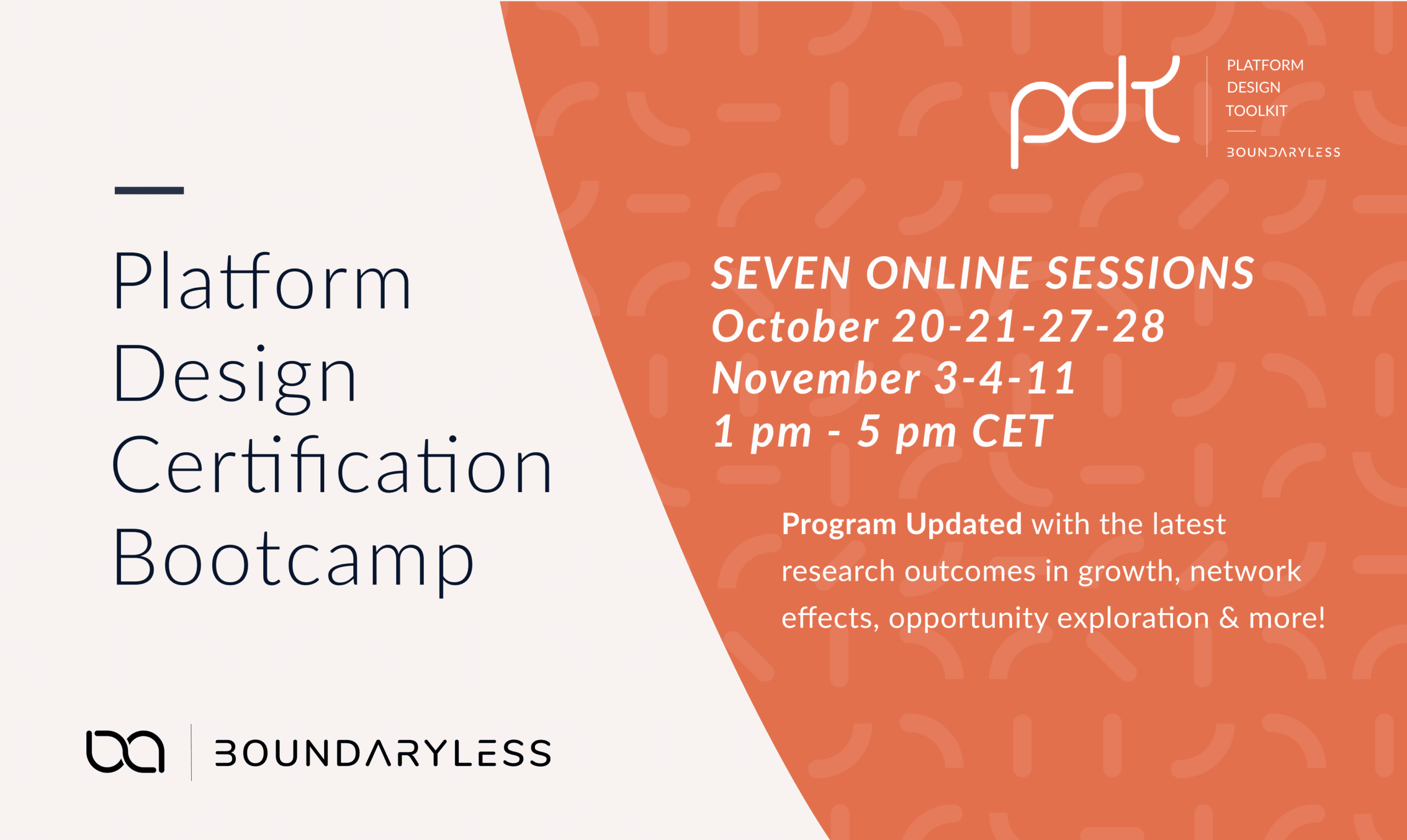Identifying a Platform Strategy Model and its potential go-to-market strategy: a streamlined process
Learn about a streamlined process to define a Platform Strategy Model and a potential “go-to-market” strategy: using the Platform Strategy Model Canvas with Boundaryless opportunity exploration and growth frameworks.
Simone Cicero

Luca Ruggeri
Abstract
In this post, we will present an alternative way to use some of our most used tools: the platform opportunity exploration framework in combination with our recently released growth tools to define what we call the Platform Strategy Model and the potential “go-to-market” strategy that one can adopt to bring it to the market.
We will also release a new draft canvas to help you in the process called Platform Strategy Model Canvas.
Subscribe to our newsletter if you don’t want to miss a thing!
From Exploration to a Platform Strategy Model, and a Growth Model
Most of you that follow the work of Boundaryless on Platform Design for a while now will probably be familiar with the structure of how we approach the question of designing a platform strategy.
At the moment we’ve released three main pieces of the Platform Design Toolkit methodology:
- our exploration framework, aimed at helping you scan areas of opportunity and then deep dive into details, analyze value chains and apply our library of platform plays to assess how a certain platform model can be developed to transform the market context;
- our design framework, aimed at helping you understand how to achieve the two most important elements of platform thinking: reducing transactions’ cost and creating learning engines and then putting everything together into well-defined scalable experiences with a certain business model;
- our product design and growth framework that helps you improve your product design and value proposition, define your strategic approach to growth (the product flywheels), how to achieve liquidity if you’re also launching a marketplace, and also nail additional elements such as pricing, growth model and metrics;
One would be tempted to think that the tools introduced above should be used in the most logical flow: first, you explore, then you design and then you focus on growth and optimization. Despite this being fairly accurate – certainly such as process will work especially in the most linear context – we’re constantly finding ourselves adopting different approaches.
Today’s post is a way to share with our community some of the new and unconventional ways we applied our toolset less as a ”chain” and more as a toolbox that can be used in many different ways to achieve different results that can help teams execute with different priorities.
One of the main emerging practices that we’re seeing lately consists in a shortcut that connects the main insights coming from exploration directly into a higher-level product design phase. Essentially, instead of diving deep into the design of a detailed experience and its related business model – we, more rapidly, create a synthetic overview of the potential product strategy, something we call a Platform Strategy Model (also called PSM).
We introduced the idea of a Platform Strategy Model (or PSM) recently in our post on Framing a Portfolio of Platform-Ecosystem strategies inside an Organization: the PSM represents clearly how a platform strategy is expressed in terms of the typical triplet of value proposition elements that normally compose it:
- a product/service bundle targeted to a certain core customer;
- one or more marketplace interfaces connecting such a customer with other types of stakeholders (normally its own customers and/or suppliers);
- an extension platform element, aimed at attracting third parties that are able to extend the core product/service bundle with extensions, plug-ins, and similar artifacts.
Bear in mind that not always all these product facets are present: sometimes you can have a SaaS product with no marketplace (eg: Substack), or – even more often – no extension platform strategy is in place. The most advanced platform strategies by the way, often have it all: Shopify, for example, features a product (a SaaS e-commerce platform for sellers), a marketplace (Shopify experts), and a couple of extension strategies (templates and Shopify apps).
So how do we get to this simplified model? The steps are those that follow:
First, we perform a certain depth of ecosystem mapping, normally through an arena scan (mapping all the adjacencies between arenas that the organization is targeting) and later with more specific ecosystem scans. We explained the process a bit in the piece Framing a Portfolio of Platform-Ecosystem strategies inside an Organization, previously introduced. As a result of such phase we normally have a set of ecosystem scans covering different arenas and lots of information on the existing interactions in the target market.
Following this step, we’ll then try using the information in the scan to isolate one or more value chains (through Wardley Maps) so as to be able to apply our library of platform plays and identify what we call the Platform Strategy Model. In our recent piece “Apply Value Chain Analysis with Wardley Maps to identify a Platform Opportunity” we explain some of the heuristics that we use to understand, based on the analysis of a certain value chain – constructed from a certain number of Ecosystem Scans – what opportunities exist to build: a product/service bundle, a marketplace, and an extension platform strategy.
It doesn’t make sense now to go back to the entire application of the framework but it’s important to remind how the value proposition heuristics we presented help one come up with a certain understanding of the potential product:

(for more details check, the piece introduce above, in sections: “What to bundle up on the product side?”, “What transactions should be streamlined?” and “What considerations to make on the lower value chain layers?”).
Once we have these insights, before – or even alternatively to – moving into the steps that characterize our platform design process documented here in the example (analysis of motivations to exchange, transactions cost reduction, learning systems to create, and experiences to design) we are increasingly moving into this type of simplified abstraction using the PSM Canvas.
The PSM Canvas

The PSM canvas gives you the possibility to create a quick overview of the platform strategy you want to build and allows you to communicate quickly with stakeholders. But the PSM is not only a communication tool: you don’t need to go deep into the details to understand the potential of a platform strategy from, for example, a growth perspective or a go-to-market penetration perspective.
Going deeper in the application of the core Platform Design Toolkit tools such as the motivations matrix, the transactions board, the learning engine canvas, and – eventually – the Platform Experience Canvas can certainly provide you with additional insights, for example in terms of:
- details about some of the channels you’ll have to build and how to facilitate transactions in the marketplace;
- some of the learning engine-related elements of the product/service bundle (onboarding features, services that can support the growth of the providers dealing with increased demand, etc…);
but these are details that you can add later and likely do not represent a decisive element with regards, for example, to understanding the basics of your growth flywheels.
Shortcutting this phase can also be useful to anticipate some of the validation work that one should do: it’s perfectly feasible to identify some key assumptions already at this stage and then use them to structure a research or validation campaign: more on the topic of approaches validation will come on a later piece on this blog.
The Go-To-Market model for your platform strategy
With a clear PSM model in mind – abstracted in the canvas – instead, we normally proceed to draft what we call the “go-to-market” model. This consists of two major things: the platform flywheel and the launch strategy.
Building the platform flywheel (by using our newly released flywheel sketching canvas and applying for the flywheel cards) is perfectly feasible starting from the Platform Strategy Model.
To build the flywheel you need indeed the framing of the key marketplace you want to build (likely a two-sided marketplace, less often one-sided), you need to know if there’s a perspective to build an extension platform (that can trigger another two-sided network effect considering the recipient of your product and the extension developer), and the characteristics of the product itself, to understand if it can generate additional defensibilities such as tech advantage, lock-in, data advantages, economies of scale or branding effects.
Below, is an example of our recently released flywheel canvas based on the content of the Prosumer Solar Energy example we released previously.

The other major element of the go-to-market model we often build at this stage is the launch strategy. Why envision a launch strategy before designing the product experience in detail one would say? Well, there are several reasons.
First of all, in many team contexts, assessing the difficulty of a launch strategy, considering for example what to expect in terms of the hardness to reach liquidity, and what tactics can be used can be helpful: the team could for example have access to some key assets that could help in the process, and clarity about the steps to liquidity may be helpful to assess the scope of the investment needed in the initial phase, thus helping a bootstrapping team size the type of investment so be sought. What we normally do with our customers is to go through two more canvases – besides the flywheel sketching: our recently released: Network Properties and NFX Canvas and the Liquidity Canvas.
Both these canvases – and the insights they bring – could certainly benefit from a finer description of the experience one wants to develop through a Platform Experience Canvas but a team could technically proceed to draft them based on the assumption detailed in the PSM canvas: if I know that I’m launching a marketplace interface, I may not have all the details of the experience steps at this stage but I’ll certainly know that there will be a relationship between a producer and a consumer and have a rough idea of what the interaction will be about: what service or product will be traded by the parties, and some of the peculiar properties that the relationship will bear (the reader will recall the 7 Key Properties of the relationship we identified in the Platform Growth and Product Guide)
Compiling the Network Properties and NFX Canvas (here you can see another example, still taken from the Prosumer Solar Energy example we previously shared) with the information you’ve at that stage will give you a precious idea of the tactics you’ll be able to use at launch (pick from our library of ten from our Growth Tactics Cheatsheet available as an addition to the Platform Growth and Product Guide).

Compiling the second one, the Liquidity Canvas will instead be essential to understand if the set of value propositions that the team has in mind, will deliver key value drivers to the parties involved, and will help identify where to constrain the network at launch (starting from a city or a category of products for example), giving the team a precious hint into where could the initial steps of the go-to-market process start.

Conclusions
In this post, we presented an alternative way to use some of our most stable tools (our platform opportunity exploration framework) to produce a synthetic PSM (Platform Strategy Model) and to connect this PSM to our recently released Growth tools to rapidly assess what we call a potential “go-to-market” model.
The process we presented today goes through the following steps:
- scan the ecosystem through Arena and Ecosystem Scans;
- abstract the value chain with the Wardley Map and apply the platform plays first, and the Platform value proposition heuristics then to derive your Synthetic PSM Model and crystalize it into the PSM Canvas;
- use the Flywheel Sketching canvas to understand the growth potential of the PSM you developed;
- use the Network Properties and NFX Canvas and the Liquidity Canvas to understand how you would have to approach the launch phase tactically, which steps would come first and in which context you would have to constrain at the start
- assess on the basis of this what kind of investments would be needed, and which other needs the team would have, and use this information strategically to interact with your stakeholders.
In this post we also released a new draft experimental canvas called the Platform Strategy Model canvas, to help adopters synthesize the information needed to describe a PSM that you can download from here.
You can also download a PDF high-quality version of the process abstraction above from here.
Furthermore in this post, we presented some additional example canvases that connect with a previously released example: these canvases are extracted from an upcoming release on the whole set of tools that Boundaryless has been creating so far as MURAL templates thanks to a collaboration we had with the company, providing one of the most used collaborative boards around. These will be released in the coming weeks so stay tuned by subscribing to our newsletter so you won’t miss the upcoming release and other instructable posts like this.
Do you want to learn how to frame your product to resonate with your Ecosystem? Learn how to design platform strategies with us at the Platform Design Bootcamp coming up in October
Join us at the upcoming Platform Design Bootcamp:
Simone Cicero


